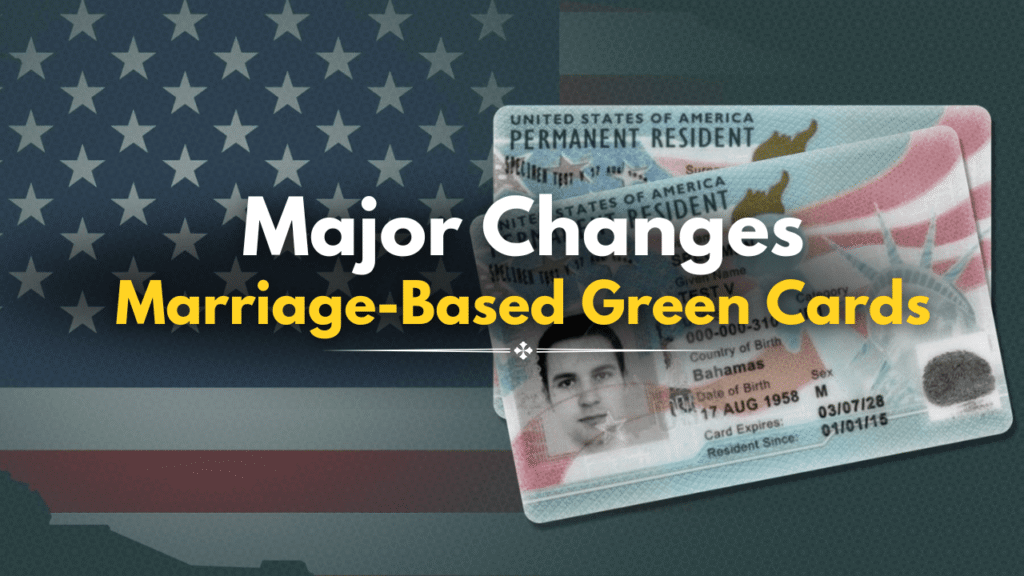A New Path to the United States,
Major Changes to Marriage-Based Green Cards in 2025: What You Need to Know

Big updates are coming to the marriage-based green card process in 2025 — and if you’re planning to apply, it’s critical that you stay informed. USCIS has introduced new forms, updated procedures, and stricter requirements that all applicants must now follow.
In this detailed guide, we’ll walk you through all the major changes to the marriage green card process this year — from new interview protocols to updated documentation expectations. We’ll also cover what’s happening at U.S. embassies and consulates abroad. Let’s dive in.
Why Are These Changes Happening Now?
In recent weeks, the U.S. government has rolled out significant form updates, including:
-
- Form I-485: Used by individuals applying for a green card from within the United States.
-
- Form I-130: Now requires more detailed relationship information and includes a serious legal statement that petitioners must read aloud during interviews.
This statement reminds applicants that entering a fraudulent marriage can lead to a $250,000 fine and up to five years in prison. USCIS officers are increasingly making petitioners recite this during interviews — a clear sign of the agency’s more aggressive stance on fraud prevention.
New Forms Are Now Mandatory
As of April 2025, the new versions of Form I-130, Form I-485, and Form I-129F (for fiancé visas) are mandatory. Submitting outdated versions will result in automatic rejection of your entire application.
Worse yet, if you’re applying from within the U.S. without legal status and your application is denied, you may be placed in removal (deportation) proceedings under the latest enforcement policies.
Green Card Processing Times Are Getting Longer
Processing times have increased substantially:
-
- Just months ago, most marriage-based green cards were processed in six months.
-
- Now, as of late April 2025, processing can take 10 to 12 months, and possibly longer later in the year.
If you’re a green card holder petitioning for a spouse, expect wait times of up to 20 months. While timelines can be shorter depending on whether you’re using the “dates for filing” chart, delays are still significant.
No More Combined Fee Payments
One important procedural change: combined payments are no longer accepted.
Previously, applicants could submit a single check covering all filing fees (biometrics, work permits, travel documents, etc.). Now, each application must have its own check or money order — and each must match the exact required amount.
Even a small mistake will cause your entire package to be returned, delaying your case and possibly affecting your legal status. Always double-check the current fee amounts on the USCIS website, highlight them, print your checklist, and only then prepare your payments.
Stronger Evidence Now Required at Filing
USCIS now requires comprehensive supporting evidence to be submitted upfront. Previously, some documents could be presented during the interview. That’s no longer the case.
You must now submit:
-
- Detailed relationship evidence (joint bills, leases, travel records, photos from the time you started dating)
-
- Medical exams at the time of filing
-
- Bank statements showing frequent joint usage — not just names on the account
In some cases, USCIS has even requested that applicants highlight individual transactions to prove they actively use joint financial accounts.
The takeaway: The more evidence you include, the smoother your process will be. Incomplete or weak documentation leads to more scrutiny and longer interviews.
Interviews Are Back — and Tougher Than Before
Marriage-based interviews are no longer routinely waived. In fact, most applicants will now be interviewed, even in straightforward cases.
Worse yet, interview procedures have changed:
-
- Interview lengths have increased from 15–30 minutes to longer, more detailed sessions.
-
- Many couples are now being separated during interviews — a practice becoming more common in cities like San Diego, Phoenix, Seattle, and New York.
This means even legitimate marriages will face more intense questioning.
Embassy and Consulate Interviews Are More Challenging Too
For those applying from abroad, U.S. consular interviews have become more demanding as well. Officers are now:
-
- Asking tougher questions
-
- Requesting additional documentation after interviews
-
- Delaying immediate approvals more often
Preparation is everything. Before attending your embassy interview, have all your documents organized, translated if needed, and ready to present. There’s often only one chance to get it right — delays can push your case into administrative processing, which may take months to resolve.
Don’t Wait — Start Preparing Now
If your case is currently at the National Visa Center (NVC), now is the time to gather your documents and prepare for your interview. Interview slots at consulates are opening up — and when you’re scheduled, you’ll want to be fully prepared with your evidence in hand.
Mistakes Now Carry Heavy Consequences
The marriage-based green card process is now under more scrutiny than ever before. One small mistake — like using an outdated form or submitting the wrong check amount — can result in a rejected application.
And under current policy, if your case is denied and you’re out of status, you may be referred to immigration court. You may not even be eligible to reapply.
So, accuracy and thoroughness are no longer optional — they’re essential.
Need Help with Your Marriage Green Card Case?
If you’re feeling overwhelmed or unsure about your case, don’t go it alone. Our team is here to help.


What Are Your Concerns?
Have questions about the new green card rules in 2025? Drop them in the comments section — we’re here to help.